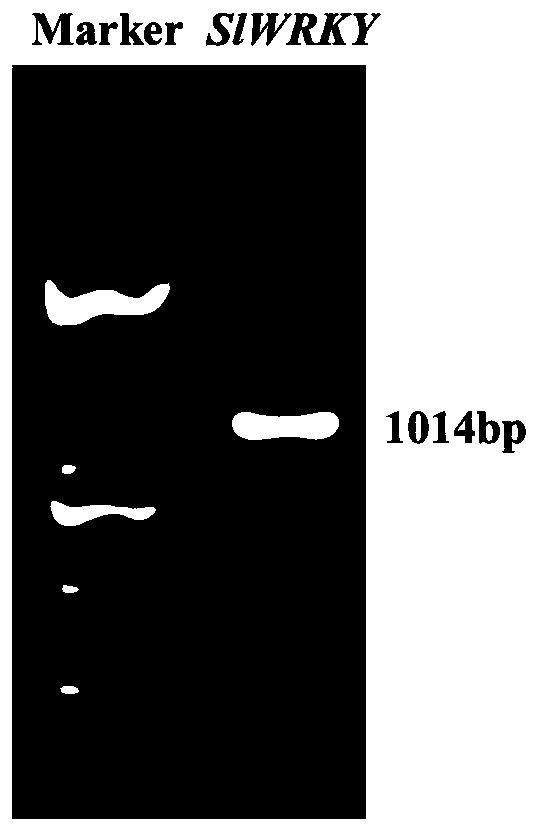Sedum lineare salt-tolerant gene SlWRKY and application thereof
A salt-tolerant gene, the technology of S. japonica, applied in the field of molecular biology and biology, can solve the problems of limiting crop types and yields, low utilization efficiency, and differences in salt tolerance.
- Summary
- Abstract
- Description
- Claims
- Application Information
AI Technical Summary
Problems solved by technology
Method used
Image
Examples
Embodiment 1
[0028] 1. Cloning of the S1WRKY gene of Sedum linearare (S1 for short)
[0029] Total RNA was extracted from S. japonica (taken from Binhai New District, Tianjin) which was treated with salt tolerance in 150mM NaCl aqueous solution, using the plant RNeasy Plant Mini Kit (Transgene Code#E101-0150rxns), and using EasyScript Frist-Strand cDNA SynSgesis SuperMix (Transgene Code#AE301-03100rxns) was reverse transcribed into cDNA. High-throughput sequencing of cDNA was performed to obtain 78407 transcripts (Novogene performed high-throughput sequencing), and the 3' end sequence of the SlWRKY gene was obtained through comparative analysis with the GO database, using RACE technology (Takara-RACE kit) The full-length cDNA sequence of the SlWRKY gene was obtained, and the amplified SlWRKY gene was sequenced and analyzed to obtain a complete SlWRKY gene with a full-length of 1014bp (SEQ ID No.1). The protein encoded by the S. japonica S1WRKY gene is the amino acid sequence shown in SEQ ...
Embodiment 2
[0080] 1. Transformation of Arabidopsis
[0081] (1) Transform Arabidopsis.
[0082] Specific steps for transforming Arabidopsis:
[0083] Nutrient soil (vermiculite: sterile mixed at a ratio of 1:3), sow Arabidopsis seeds (commercial) vernalized in a refrigerator at 4°C for 72 hours on the soil surface, cover with plastic wrap for the first 7 days, and put them in tissue culture on the shelf. The culture conditions are as follows: the light is 10000 lux; the daytime is 16 hours, 22°C; the night is 8 hours, the temperature is 18°C. Cut off the fruit pods and pollinated flowers of Arabidopsis thaliana that have grown for 1.5 months and bolted about 15 cm. Pick a single colony containing gene-positive clones into 50 mL of YEB liquid medium containing 30 μg / mL gentamicin, 50 μg / mL rifampicin, and 50 μg / mL kanamycin (5 g peptone, 1 g yeast extract, 5 g beef extract , 5 g of sucrose, dilute to 1 L, pH = 7), 28 ° C, 180 rpm, until the OD600 value is 0.6-0.8. Centrifuge the bact...
Embodiment 3
[0089] 1. Transform poplar
[0090] The poplars transformed by the positive clones were Populus alba × P. alba INRA clone N7171-B4 (hereinafter referred to as 717 poplars) tissue culture seedlings. (commodity)
[0091] (1) Put the axillary buds or terminal buds of 717 poplar on the basic medium (MS salt 2.2g, sucrose 30g, constant volume to 1L, pH=5.7, agar 7.2g) for subculture, and culture for 6 weeks to obtain tissue culture seedlings ; Cut off the 1cm stem section without axillary buds of the tissue cultured seedlings, and pre-cultivate them under dark conditions at 24°C for 3 days after scratching the wound;
[0092](2) The positive clone bacterial liquid (OD600=0.8) obtained by the selected embodiment 1 is centrifuged at room temperature and 4000rpm for 10min, the supernatant is discarded, and an equal volume of M solution (M solution: MS salt 4.4g) is used for the precipitation , sucrose 30g, auxin NAA1.86mg, cytokinin 2ip1.02mg, acetosyringone As19.86mg, dilute to 1L,...
PUM
 Login to View More
Login to View More Abstract
Description
Claims
Application Information
 Login to View More
Login to View More - R&D
- Intellectual Property
- Life Sciences
- Materials
- Tech Scout
- Unparalleled Data Quality
- Higher Quality Content
- 60% Fewer Hallucinations
Browse by: Latest US Patents, China's latest patents, Technical Efficacy Thesaurus, Application Domain, Technology Topic, Popular Technical Reports.
© 2025 PatSnap. All rights reserved.Legal|Privacy policy|Modern Slavery Act Transparency Statement|Sitemap|About US| Contact US: help@patsnap.com



